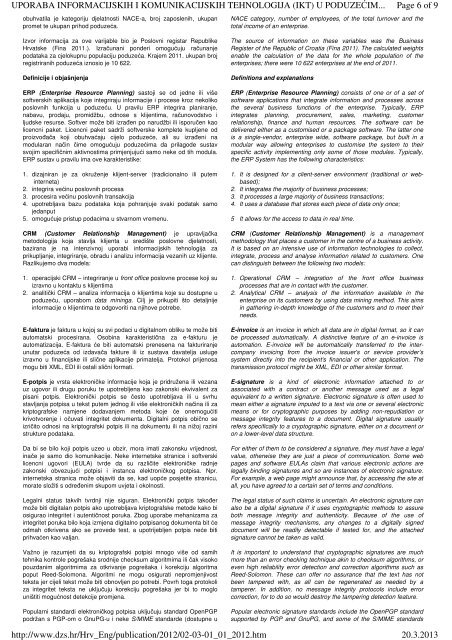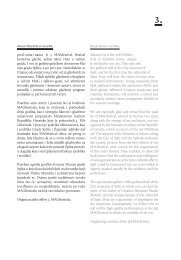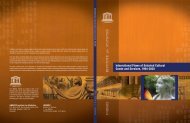ikt - Culturenet
ikt - Culturenet
ikt - Culturenet
Create successful ePaper yourself
Turn your PDF publications into a flip-book with our unique Google optimized e-Paper software.
http://www.dzs.hr/Hrv_Eng/publication/2012/02-03-01_01_2012.htm<br />
20.3.2013<br />
UPORABA INFORMACIJSKIH I KOMUNIKACIJSKIH TEHNOLOGIJA (IKT) U PODUZEĆIM...<br />
obuhvatila je kategoriju djelatnosti NACE-a, broj zaposlenih, ukupan<br />
promet te ukupan prihod poduzeća.<br />
Page 6 of 9<br />
NACE category, number of employees, of the total turnover and the<br />
total income of an enterprise.<br />
Izvor informacija za ove varijable bio je Poslovni registar Republike<br />
Hrvatske (Fina 2011.). Izračunani ponderi omogućuju računanje<br />
podataka za cjelokupnu populaciju poduzeća. Krajem 2011. ukupan broj<br />
registriranih poduzeća iznosio je 10 622.<br />
Definicije i objašnjenja<br />
ERP (Enterprise Resource Planning) sastoji se od jedne ili više<br />
softverskih aplikacija koje integriraju informacije i procese kroz nekoliko<br />
poslovnih funkcija u poduzeću. U pravilu ERP integrira planiranje,<br />
nabavu, prodaju, promidžbu, odnose s klijentima, računovodstvo i<br />
ljudske resurse. Softver može biti izrañen po narudžbi ili isporučen kao<br />
licencni paket. Licencni paket sadrži softverske komplete kupljene od<br />
proizvoñača koji obuhvaćaju cijelo poduzeće, ali su izrañeni na<br />
modularan način čime omogućuju poduzećima da prilagode sustav<br />
svojim specifičnim aktivnostima primjenjujući samo neke od tih modula.<br />
ERP sustav u pravilu ima ove karakteristike:<br />
The source of information on these variables was the Business<br />
Register of the Republic of Croatia (Fina 2011). The calculated weights<br />
enable the calculation of the data for the whole population of the<br />
enterprises; there were 10 622 enterprises at the end of 2011.<br />
Definitions and explanations<br />
ERP (Enterprise Resource Planning) consists of one or of a set of<br />
software applications that integrate information and processes across<br />
the several business functions of the enterprise. Typically, ERP<br />
integrates planning, procurement, sales, marketing, customer<br />
relationship, finance and human resources. The software can be<br />
delivered either as a customised or a package software. The latter one<br />
is a single-vendor, enterprise wide, software package, but built in a<br />
modular way allowing enterprises to customise the system to their<br />
specific activity implementing only some of those modules. Typically,<br />
the ERP System has the following characteristics:<br />
1. dizajniran je za okruženje klijent-server (tradicionalno ili putem 1. It is designed for a client-server environment (traditional or webbased);<br />
interneta)<br />
2. integrira većinu poslovnih procesa 2. It integrates the majority of business processes;<br />
3. procesira većinu poslovnih transakcija 3. It processes a large majority of business transactions;<br />
4. upotrebljava bazu podataka koja pohranjuje svaki podatak samo 4. It uses a database that stores each piece of data only once;<br />
jedanput<br />
5. omogućuje pristup podacima u stvarnom vremenu. 5 It allows for the access to data in real time.<br />
CRM (Customer Relationship Management) je upravljačka<br />
metodologija koja stavlja klijenta u središte poslovne djelatnosti,<br />
bazirana je na intenzivnoj uporabi informacijskih tehnologija za<br />
prikupljanje, integriranje, obradu i analizu informacija vezanih uz klijente.<br />
Razlikujemo dva modela:<br />
1. operacijski CRM – integriranje u front office poslovne procese koji su<br />
izravno u kontaktu s klijentima<br />
2. analitički CRM – analiza informacija o klijentima koje su dostupne u<br />
poduzeću, uporabom data mininga. Cilj je prikupiti što detaljnije<br />
informacije o klijentima te odgovoriti na njihove potrebe.<br />
E-faktura je faktura u kojoj su svi podaci u digitalnom obliku te može biti<br />
automatski procesirana. Osobina karakteristična za e-fakturu je<br />
automatizacija. E-faktura će biti automatski prenesena na fakturiranje<br />
unutar poduzeća od izdavača fakture ili iz sustava davatelja usluge<br />
izravno u financijske ili slične aplikacije primatelja. Protokol prijenosa<br />
mogu biti XML, EDI ili ostali slični formati.<br />
E-potpis je vrsta elektroničke informacije koja je pridružena ili vezana<br />
uz ugovor ili drugu poruku te upotrebljena kao zakonski ekvivalent za<br />
pisani potpis. Elektronički potpis se često upotrebljava ili u svrhu<br />
stavljanja potpisa u tekst putem jednog ili više elektroničkih načina ili za<br />
kriptografske namjene dodavanjem metoda koje će onemogućiti<br />
krivotvorenje i očuvati integritet dokumenta. Digitalni potpis obično se<br />
izričito odnosi na kriptografski potpis ili na dokumentu ili na nižoj razini<br />
strukture podataka.<br />
Da bi se bilo koji potpis uzeo u obzir, mora imati zakonsku vrijednost,<br />
inače je samo dio komunikacije. Neke internetske stranice i softverski<br />
licencni ugovori (EULA) tvrde da su različite elektroničke radnje<br />
zakonski obvezujući potpisi i instanca elektroničkog potpisa. Npr.<br />
internetska stranica može objaviti da se, kad uopće posjetite stranicu,<br />
morate složiti s odreñenim skupom uvjeta i okolnosti.<br />
Legalni status takvih tvrdnji nije siguran. Elektronički potpis takoñer<br />
može biti digitalan potpis ako upotrebljava kriptografske metode kako bi<br />
osigurao integritet i autentičnost poruka. Zbog uporabe mehanizama za<br />
integritet poruka bilo koja izmjena digitalno potpisanog dokumenta bit će<br />
odmah otkrivena ako se provede test, a upotrijebljen potpis neće biti<br />
prihvaćen kao valjan.<br />
Važno je razumjeti da su kriptografski potpisi mnogo više od samih<br />
tehnika kontrole pogrešaka srodnije checksum algoritmima ili čak visoko<br />
pouzdanim algoritmima za otkrivanje pogrešaka i korekciju algoritma<br />
poput Reed-Solomona. Algoritmi ne mogu osigurati nepromjenjivost<br />
teksta jer cijeli tekst može biti obnovljen po potrebi. Povrh toga protokoli<br />
za integritet teksta ne uključuju korekciju pogrešaka jer bi to moglo<br />
uništiti mogućnost detekcije promjena.<br />
Popularni standardi elektroničkog potpisa uključuju standard OpenPGP<br />
podržan s PGP-om o GnuPG-u i neke S/MIME standarde (dostupne u<br />
CRM (Customer Relationship Management) is a management<br />
methodology that places a customer in the centre of a business activity.<br />
It is based on an intensive use of information technologies to collect,<br />
integrate, process and analyse information related to customers. One<br />
can distinguish between the following two models:<br />
1. Operational CRM – integration of the front office business<br />
processes that are in contact with the customer.<br />
2. Analytical CRM – analysis of the information available in the<br />
enterprise on its customers by using data mining method. This aims<br />
in gathering in-depth knowledge of the customers and to meet their<br />
needs.<br />
E-invoice is an invoice in which all data are in digital format, so it can<br />
be processed automatically. A distinctive feature of an e-invoice is<br />
automation. E-invoice will be automatically transferred to the intercompany<br />
invoicing from the invoice issuer's or service provider’s<br />
system directly into the recipient's financial or other application. The<br />
transmission protocol might be XML, EDI or other similar format.<br />
E-signature is a kind of electronic information attached to or<br />
associated with a contract or another message used as a legal<br />
equivalent to a written signature. Electronic signature is often used to<br />
mean either a signature imputed to a text via one or several electronic<br />
means or for cryptographic purposes by adding non-repudiation or<br />
message integrity features to a document. Digital signature usually<br />
refers specifically to a cryptographic signature, either on a document or<br />
on a lower-level data structure.<br />
For either of them to be considered a signature, they must have a legal<br />
value, otherwise they are just a piece of communication. Some web<br />
pages and software EULAs claim that various electronic actions are<br />
legally binding signatures and so are instances of electronic signature.<br />
For example, a web page might announce that, by accessing the site at<br />
all, you have agreed to a certain set of terms and conditions.<br />
The legal status of such claims is uncertain. An electronic signature can<br />
also be a digital signature if it uses cryptographic methods to assure<br />
both message integrity and authenticity. Because of the use of<br />
message integrity mechanisms, any changes to a digitally signed<br />
document will be readily detectable if tested for, and the attached<br />
signature cannot be taken as valid.<br />
It is important to understand that cryptographic signatures are much<br />
more than an error checking technique akin to checksum algorithms, or<br />
even high reliability error detection and correction algorithms such as<br />
Reed-Solomon. These can offer no assurance that the text has not<br />
been tampered with, as all can be regenerated as needed by a<br />
tamperer. In addition, no message integrity protocols include error<br />
correction, for to do so would destroy the tampering detection feature.<br />
Popular electronic signature standards include the OpenPGP standard<br />
supported by PGP and GnuPG, and some of the S/MIME standards
















